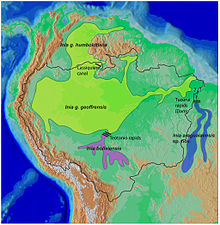Amazon dolphin
| Amazon dolphin | ||||||||||||
|---|---|---|---|---|---|---|---|---|---|---|---|---|

Amazon dolphin in the Duisburg Zoo |
||||||||||||
| Systematics | ||||||||||||
|
||||||||||||
| Scientific name | ||||||||||||
| Inia geoffrensis | ||||||||||||
| ( Blainville , 1817) |
The Amazon dolphin ( Inia geoffrensis ), also called boto , is one of the three species of Amazon river dolphins that are common in South America . The Amazon Sotalia , which also occurs in the Amazon, is a representative of the actual dolphins .
properties
Appearance
Amazon dolphins grow to be 2 to 3 meters long and weigh 85 to 160 kilograms. Their color changes with age: young animals are silver-gray, older Amazon dolphins turn pink. The head is rounded, the long snout clearly set off from it. The eyes are tiny and stunted, but are still functional. Unique among all river dolphins is the hairiness of the snout, which is covered with stiff bristles. His cervical vertebrae are not fused, which makes him particularly flexible. His shoulder joint is also not fused in the way that is typical for whales and dolphins . A peculiarity of the Amazon dolphin is that its dentition does not consist of homogeneous teeth, but rather broader teeth are present in the rear area of the snout. These enable large prey fish to be chewed and tanks to be broken.
Way of life
As a solitary animal, the Amazon dolphin is rarely seen together with other species. He avoids the big rivers and prefers to stay in the swampy, standing side arms. Here it does not need its already stunted sense of sight, but relies entirely on echolocation when looking for its prey, which mainly consists of small fish. Amazon dolphins only dive briefly and come up to the surface to breathe about every thirty seconds. They are less active than oceanic dolphins and hardly ever jump.
distribution

the Inia araguaiaensis (blue)
and the Inia boliviensis (violet)
There are two different subspecies, both of which are common in the northern half of South America:
- I. g. geoffrensis , in the Amazon and many of its tributaries
- I. g. humboldtiana , also known as Tonina , in the Orinoco and its tributaries
The Inia boliviensis in the upper reaches of the Rio Madeira , which is a tributary of the Amazon but is separated from it by a series of rapids and waterfalls, is now considered an independent species, which was formerly considered a subspecies by I. geoffrensis about 2, Was isolated 8 million years ago.
Among the river dolphins, the Amazon dolphin is the least endangered species. However, it is listed as endangered by the IUCN . He occasionally gets caught in fishing nets or his curiosity gets caught in ship propellers. Regionally he is killed by fishermen who see him as a competitor in fishing. The Amazon dolphin is also potentially endangered by dams and river pollution.
designation
In addition to the common name Amazon dolphin, this species of dolphin has a number of other names. In German, the form of the Amazon river dolphin is also known, which only describes the habitat. Common forms are the Boto , Bofeo or Tonina derived from the Amazon region. From the English the variants Amazon River Dolphin , Pink River Dolphin (" Pink River Dolphin "), Pink Dolphin ("Pink Dolphin"), Pink Freshwater Dolphin (" Pink Freshwater Dolphin ") and Pink Porpoise ("Pink Porpoise") are known. Other variants are Dauphin de l'Amazone ("Amazon Dolphin") , Boto Cor-de-rosa ("Pink Dolphin") and Boto Vermelho ("Red Dolphin"). All names stand for the Amazon dolphin Inia geoffrensis .
Systematics
The Amazon dolphin is an independent species within the Amazon river dolphins (family Iniidae, genus Inia ), which currently consists of three species.
The systematics within the various river dolphins is controversial. While all representatives of this group used to be regarded as convergent and not related to each other, even after molecular genetic studies it is now assumed that the La Plata dolphin and probably also the possibly extinct Chinese river dolphin are related to the Amazon river dolphins.
Others
mythology
Some indigenous peoples believe that a drowned person will become a river dolphin. In this new life, the river dolphin retains the ability to transform itself back into a human on occasional shore leave.
Some people on the Rio Negro believe that the Amazon dolphin comes ashore at night as a handsome young man in a white suit with a hat looking for young girls. That is why every strange young man is initially viewed with suspicion. The transformed dolphin seduces the young girl and then disappears the next morning in the river as a dolphin. The girl becomes pregnant and eventually the child is born. There are indeed birth certificates in which “Boto Cor de Rosa” is entered as the father.
Keeping in animal parks
Since 1975, aquariums have only been kept outside of Venezuela in the Duisburg Zoo . In 2006, the Duisburg animal Apure died of old age at the age of almost 50. Only one specimen of the Amazon dolphin called Butu lives in the Duisburg Zoo , which has been the only Amazon dolphin in human care since the death of the last two Amazon dolphins in the Valencia Aquarium in Venezuela in 2016.
literature
- DE Wilson, DM Reeder: Mammal Species of the World . Johns Hopkins University Press , 2005, ISBN 0-8018-8221-4
Web links
- Information about Amazon dolphins
- Inia geoffrensis in the endangered Red List species the IUCN 2006. Posted by: Cetacean Specialist Group, 1996. Retrieved on 11 May, 2006.
- badische-zeitung.de , April 11, 2018, Philipp Lichterbeck: The message of the pink dolphins
Individual evidence
- ↑ M. Ruiz-García, S. Caballero, M. Martinez-Agüero, JM Shostell JM: Molecular differentiation among Inia geoffrensis and Inia boliviensis (Iniidae, Cetacea) by means of nuclear intron sequences. In: VT Koven (Ed.): Population Genetics Research Progress. Boca Raton, Nova Publishers 2008; Pp. 177-203.
